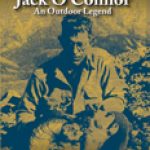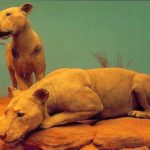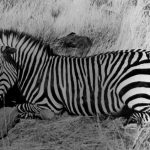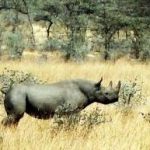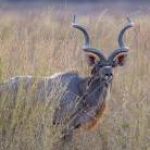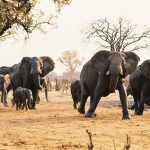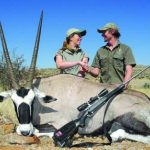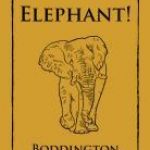A chat with the man who handled elephants, lions, and cheetahs during the filming of the 1962 classic movie starring John Wayne.
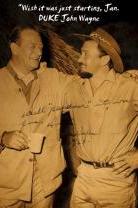
Of the cast and crew, both human and animal, who assembled half a century ago in east Africa to make the iconic safari movie Hatari!, only a few are still around. Star John Wayne, director Howard Hawks, and screenwriter Leigh Brackett all died more than 30 years ago, and actors Red Buttons, Bruce Cabot, Gérard Bain, and Michèle Girardon have joined them. Most of the professional hunters who worked as technical advisors, guides, doubles, security, wildlife wranglers, and capturers, have also passed on.
The principal game handler for the movie was the legendary Willie de Beer, owner of Tanganyika Game Limited, licensed for capturing wildlife; and working for him was a young Jan Oelofse. Today, Oelofse owns Jan Oelofse Hunting Safaris in Namibia and has recently published his memoir, Capture to Be Free, authored by his wife Annette Oelofse and available from www.janoelofsesafaris.com for $70.00 plus $12.00 shipping. Tom McIntyre interviewed Oelofse by phone to ask him about his memories of having worked on Hatari!
Tom McIntyre: Do you mind giving out your age?
Jan Oelofse: My age is 77. I’ll be 78 this year.
Tom McIntyre: How did you come to be a part of Hatari!?
Jan Oelofse: I was working for an old gentleman in Tanzania (it was Tanganyika at the time), Mr. de Beer, and Paramount [Pictures] wanted to do a movie, an African movie, and they came out and visited our camp. And the movie was more or less based on our lives there at the time. And since I was working for him [Willie de Beer], I was a participant in helping to work on the movie. He got the contract and, you know, I was a young man at the time, 50 years younger than I am now, and that’s how it happened.
Tom McIntyre: What can you tell me about Willie de Beer?
Jan Oelofse: His parents left South Africa. A lot of the Afrikaans-speaking people left South Africa after the Boer War. Early in the 1900s, when he was a small boy, his parents went up to Tanganyika. And there they settled, and he started in his young days to capture game. And it was always a dream for me to go and work with animals, and Tanganyika was the mecca of wildlife at that time. And then eventually I ended up with him. He was like a father to me, actually.
Tom McIntyre: How did you get to Tanganyika?
Jan Oelofse: I came up from Namibia, which was South-West Africa at the time [in the mid-1950s]. I worked a while in Zambia–I ran out of money by the time I got there. So I worked there for a few months, and then I continued up to Tanganyika.
Tom McIntyre: Before we talk about Hatari!, tell me about your career after the movie.
Jan Oelofse: I left East Africa in 1964. After independence, it was very difficult to get work permits there if you were of Western descent. So then I went back to South Africa, and I joined the Natal Parks Board. And I worked for them for eight years; and then during that time I designed a technique to capture animals in the thousands, and that really was the forerunner of the whole game industry in South Africa today. Previously, they couldn’t farm with game because it was difficult to obtain, because it was very hard to capture. With my technique, I could capture hundreds and hundreds in a day; and then it made it possible for people to buy game and stock their ranches and turn large areas over to conservation areas that were previously used for [cattle and sheep]. I [also] did a lot of movies for Mutual of Omaha, Marlin Perkins. I did a whole lot, about 20 series for him. I was quite involved in movie making until about 20 years ago or so.
[Oelofse’s memoir describes how he went into the private game-capturing business in 1973, using the now well-known “Oelofse Method” to capture wildlife and supply it all over southern Africa. Eventually he purchased a ranch in Namibia for surplus wildlife, turning it into the 60,000 acre Okonjati Game Sanctuary and Mount Etjo Safari Lodge. In 1982 Oelofse was named SCI’s “Most Outstanding Hunter.”]
Tom McIntyre: When did you first start work on the movie?
Jan Oelofse: I had been working for him [de Beer] for quite a while before the movie started. And the animals were all entrusted to my care, all the captive animals. About a year before the film crew came, I captured [the animals] myself, most of them. I started training the elephants for the movie for any parts they had to play, so I was involved quite a while with it. They [the young elephants] accepted me as a matriarch, and they followed me everywhere I’d go, and I actually slept a lot of nights with them in the cages, initially, to help them get used to me and so on.
Tom McIntyre: What were some of your jobs on the movie?
Jan Oelofse: I worked with leopards and all sorts of things and in some of the scenes we were capturing animals. We were doubling and standing in for some of the actors. But my main thing was to let the elephants do what they [the film crew] wanted them to do, and I also had a cheetah there that I brought from Namibia. Her name was Sonia. She also appeared prominently in the movie.
Tom McIntyre: Was Sonia the cheetah that came in while Elsa Martinelli was in the bath?
Jan Oelofse: Right. I was lying behind the bath, and I could see… I think I am one of the few guys that saw Martinelli’s buttocks (laughs). I lay behind the bath, and I called the cheetah in. She would only respond to me, you know. And then she walked up to Martinelli, and we put egg yolk and stuff that smelled like blood on her legs to attract her, and it was supposed to be soap that she was licking off.
Tom McIntyre: What other animals did you work with?
Jan Oelofse: I had about 42 animals, which included cheetahs, hyenas, lions, leopards, elephants, and some birds.
Tom McIntyre: But your main duty was the elephants?
Jan Oelofse: Yeah, I was involved in all the scenes. The elephants wouldn’t respond to anybody but me. And wherever you see the elephants, I was somewhere in the background or somewhere just out of screen, to control them. And when they ran down the street [in Arusha in the final scene], they were running after me. I was just out of view of the cameras.
Tom McIntyre: What was John Wayne like?
Jan Oelofse: He was a very nice gentleman and I spent a lot of time with him. Off set sometimes I took him out into the veldt and we went hunting and game viewing. I had good impressions of most of the stars. I can’t say bad about any of them. They were all nice people. And my only sad moment was when I had to leave all my elephants behind after we finished the shooting in Hollywood.
Tom McIntyre: How did the animals get to Hollywood?
Jan Oelofse: We did the movie in a couple of months in East Africa and then we moved across. I came in a plane across from Africa to Burbank Airport in Los Angeles. It took us five days with a DC 6 at that time. I was a couple of months in Hollywood. I can’t remember exactly how long now.
Tom McIntyre: Did you consider staying in Hollywood?
Jan Oelofse: Yeah, you know, it was a whole new world to me. But I was always yearning to go back to Africa. After I finished, I went on a tour through America and then Europe, and then I went back to East Africa again.
Tom McIntyre: And the animals?
Jan Oelofse: Paramount bought them from Mr. de Beer, and at that time I was just working for him. Once they finished the movie, I delivered them all to San Diego [the San Diego Zoo].
Tom McIntyre: How did you feel about that?
Jan Oelofse: You know, it was all in day’s work to me. It is the kind of work I did and I liked to do, and it was a wonderful experience for me. It was just sad to leave them behind in the States.
[As McIntyre talked to Oelofse about the elephants, Oelofse remembered there were five young ones he brought to Hollywood and then delivered to the San Diego Zoo, and he had long wondered what had become of them. By going on the internet, McIntyre learned that at least four, the only four recorded to have been donated by Paramount, are now dead. They died at relatively young ages, for elephants, none having gotten out of their 30s.]
Jan Oelofse: I am actually sad to know that they died. Since elephants normally grow quite old, there was probably something wrong with their diet or whatever that they died so early. I would have loved to have made acquaintance with them again after 50 years, but now it’s too late. My God, they probably missed me. Yeah, what a shame.
Tom McIntyre: I found out that the oldest female, Hatari, had a calf, which could still be alive.
Jan Oelofse: She certainly wouldn’t know me (laughs).
Read Tom McIntyre’s full feature on the 50th anniversary of the movie HATARI! in the May/June 2012 issue of Sports Afield. You can follow Tom on Twitter @mcintyrehunts.

